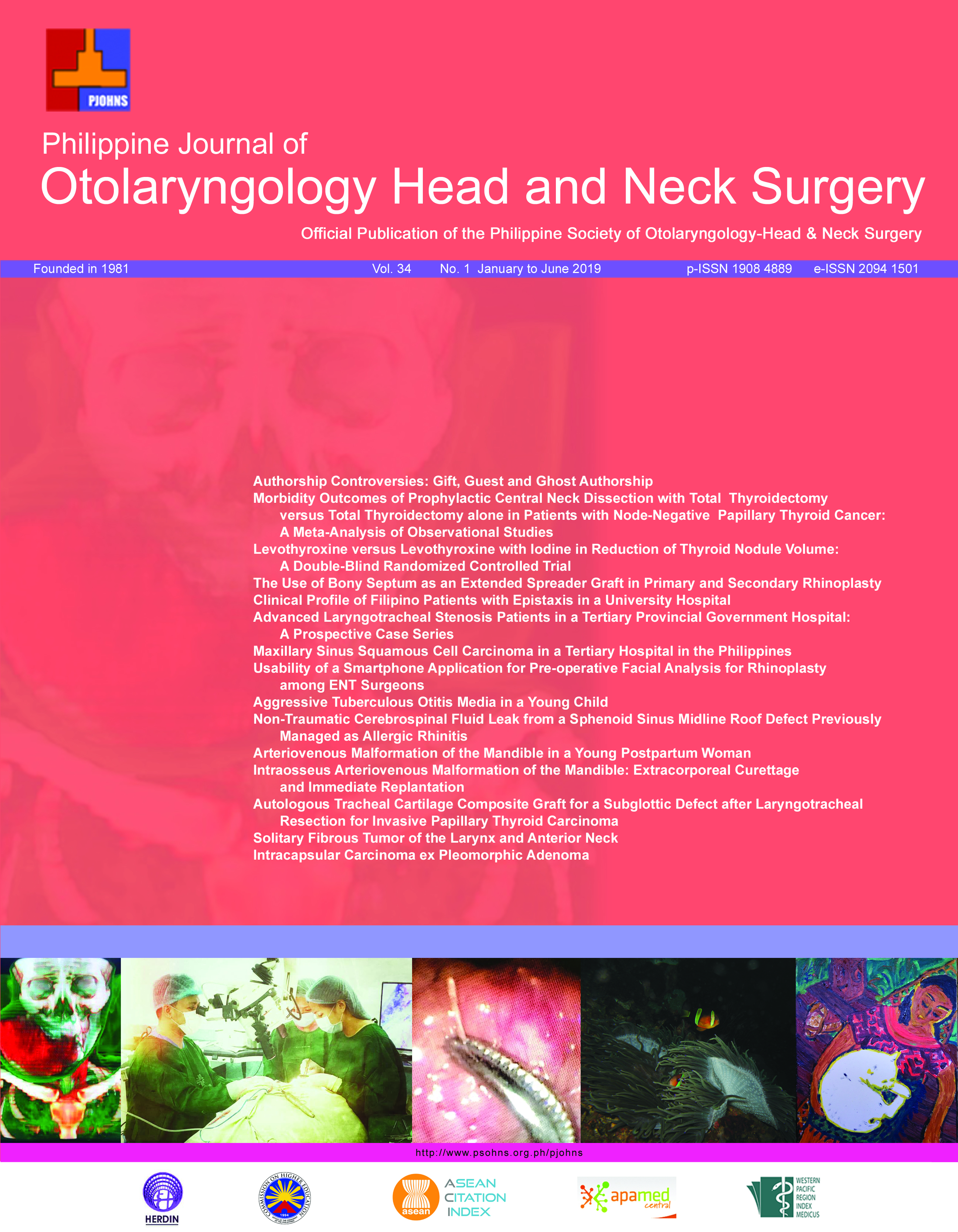Intracapsular Carcinoma ex Pleomorphic Adenoma
DOI:
https://doi.org/10.32412/pjohns.v34i1.975Keywords:
carcinomas, adenomas, neoplasmsAbstract
This is the case of a 37-year-old female patient presenting with a 10-year history of a gradually enlarging right infra-auricular mass. A parotidectomy was performed. The surgical pathology specimen consisted of an 18 cm diameter encapsulated nodular mass with a homogenous, cream-tan solid surface. Microscopic section showed an encapsulated neoplasm with abundant chondromyxoid stroma and tubular epithelial elements characteristic of a pleomorphic adenoma. (Figure 1) Randomly scattered within the tumor were foci of haphazard and complex glands. (Figure 2) These glands exhibited nuclear pleomorphism, luminal necrosis, and mitoses compatible with an adenocarcinomatous proliferation. (Figure 3) Based on these features, the case was signed out as an intracapsular carcinoma ex pleomorphic adenoma.
Carcinoma ex pleomorphic adenoma is a carcinoma arising from a pre-existing pleomorphic adenoma. The antecedent benign tumor may either be a long-standing one, often with a history measured in decades, or characterized by a protracted history of excisions and multiple recurrences.1,2 The carcinoma on the other hand is either epithelial or myoepithelial in derivation. By morphologic sub-type, the most commonly reported carcinoma arising in a pleomorphic adenoma is a salivary duct carcinoma or an adenocarcinoma that is not otherwise specified (NOS).1,3 Residual pleomorphic adenoma tissue is identifiable either in its typical morphology, a chondromyxoid stroma, or a hyalinized sclerotic nodule.1
Aside from the type of carcinoma arising from the pleomorphic adenoma, another parameter that has to be reported is the extent of involvement by the carcinomatous component. A carcinoma that is entirely limited to within the parent tumor that is still enclosed by a complete capsule is termed an “intracapsular” or “non-invasive” carcinoma ex pleomorphic adenoma.1,2 Once the carcinoma breaches the capsule and infiltrates the surrounding tissue, then it is considered invasive. If the invasion is less than 4 – 6 mm beyond the capsular border, the tumor is termed “minimally invasive”. Carcinomatous elements that extend beyond this threshold is termed “widely invasive”.1 This threshold is greater than the previous threshold of 1.5 mm recommended in an earlier edition of the WHO classification although the present edition does state that this threshold is preliminary and requires further validation.1,2,4 It has to be pointed out though that quantifying invasion may not always be possible in tumors that have positive margins, those that are intrinsically unencapsulated such as minor salivary gland tumors, and those with complex multinodular growth patterns such as in recurrent pleomorphic adenoma.1 This difficulty has to be stated in the report and what conditions preclude quantifying the degree of invasion.
Non-invasive carcinoma ex pleomorphic adenoma has quite a good outcome with very low reported rates of recurrence or regional metastasis. In a review of thirty cases and a report of an additional three cases, only one case showed recurrence or metastasis.3 This favorable outcome certainly contrasts with that of the widely invasive type where metastasis is reported to occur in up to 70% of cases.1 Another review of ten cases showed one case developing metastasis, and recommended that non-invasive cases should thus still be followed up closely after primary treatment because regional or distant metastasis can occur.2
To the best of our knowledge, there are no published local data on the incidence of early malignant transformation of pleomorphic adenomas in the Filipino population. Hence, we take this opportunity to report this case. Awareness of the entity and prudent liberal sampling of these tumors may help address this gap.
Downloads
Published
How to Cite
Issue
Section
License
Copyright transfer (all authors; where the work is not protected by a copyright act e.g. US federal employment at the time of manuscript preparation, and there is no copyright of which ownership can be transferred, a separate statement is hereby submitted by each concerned author). In consideration of the action taken by the Philippine Journal of Otolaryngology Head and Neck Surgery in reviewing and editing this manuscript, I hereby assign, transfer and convey all rights, title and interest in the work, including copyright ownership, to the Philippine Society of Otolaryngology Head and Neck Surgery, Inc. (PSOHNS) in the event that this work is published by the PSOHNS. In making this assignment of ownership, I understand that all accepted manuscripts become the permanent property of the PSOHNS and may not be published elsewhere without written permission from the PSOHNS unless shared under the terms of a Creative Commons Attribution-NonCommercial-NoDerivatives 4.0 International (CC BY-NC-ND 4.0) license.



